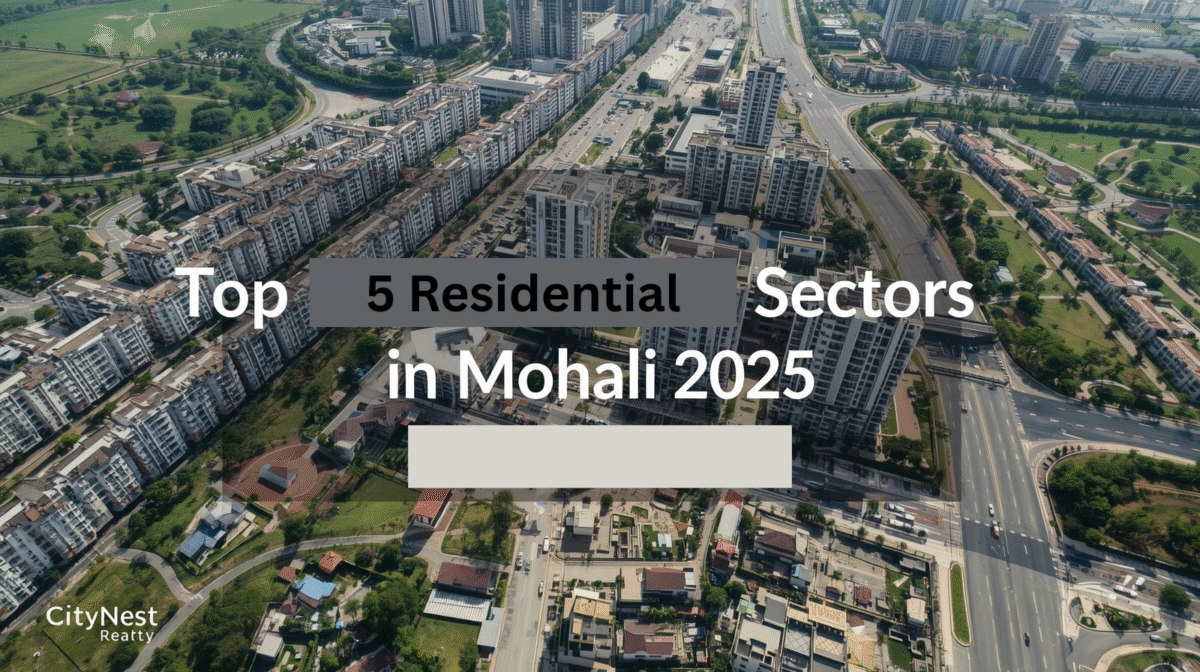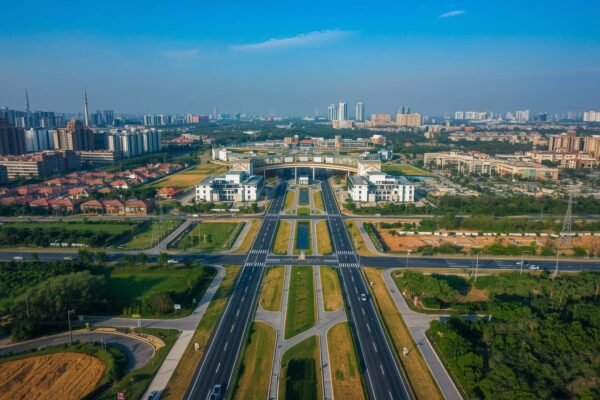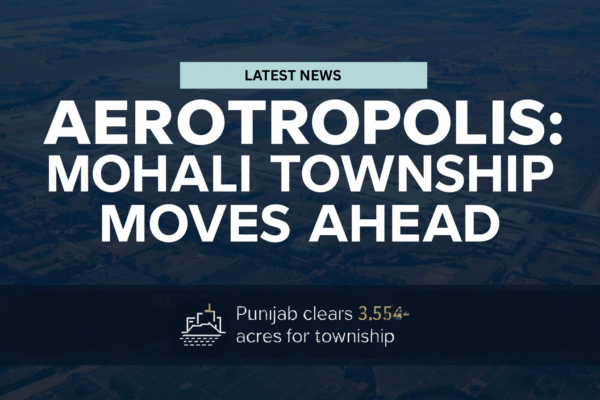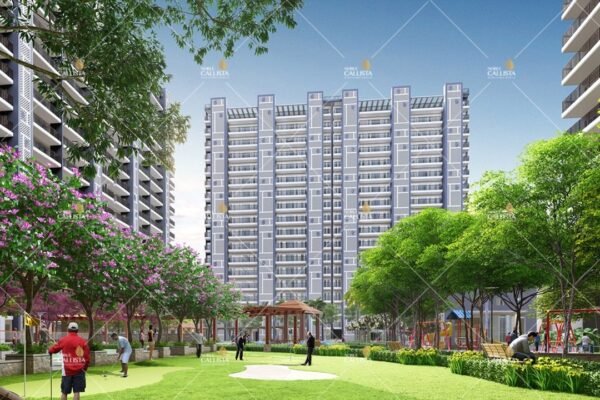Estimated reading time: 7 minutes
Mohali’s real estate boom is centered on a few key pockets. In 2025, five sectors – 78, 79, 80, 88, and 89 – stand out as Mohali’s top residential sectors, drawing homebuyers with new projects and strong connectivity. Data from local developers show Mohali values rose 8–11% in 2024, led by demand in Sectors 79 and 80. These areas offer a mix of upcoming GMADA plots, mid-segment flats, and planned infrastructure (roads, airport link, metro), setting the stage for steady price gains.
CityNest Realty analysis finds these sectors combining affordability with lifestyle perks. In this article, we explore each sector’s highlights, market trends, buyer sentiment, and growth drivers – all backed by expert data and credible sources.
Market/Project Overview
- Sector 79: A prime sector near the airport, Sector 79 is Mohali’s hottest market. Government-led housing flats and new condominium launches populate this area. Average prices here are now around ₹19,800 per sq ft – the highest among Mohali sectors – reflecting 2024’s sharp price rise. Developers report that demand in Sector 79 (and neighboring Sector 80) helped Mohali values jump 8–11% last year. Its appeal comes from proximity to the IT corridor and easy airport access, making it a first choice for many buyers.
- Sector 80: Directly adjacent to 79, this sector has rapidly caught up. It features residential layouts and newly plotted colonies that offer a slightly lower entry point. The average price in Sector 80 is about ₹15,259/sq ft, up ~11% year-on-year. Buyers here are often investors and young families eyeing value – they get similar benefits to Sector 79 but at roughly 20–25% lower cost.
- Sector 78: Bordering the IT City, Sector 78 combines established roads, parks, and schools (e.g., Shivalik International School) with emerging housing projects. Housing.com data show Sector 78’s average rate at ~₹16,343/sq ft, up about 15% from last year. This mid-range sector is popular with end-users (families and mid-income buyers) seeking ready amenities and reliable builder names.
- Sector 88: This sector is dominated by GMADA’s Purab Premium Apartments – 1,620 flats, which the authority built in 2017. After initial delays, GMADA began auctioning the remaining unsold units in 2025; reserve prices are steep (e.g., ₹1.12 Cr for a 3BHK), signaling the premium value of ready flats in this area. Sector 88 also benefits from GMADA’s planned upgrades: it is currently under active development (infrastructure, utilities) as an “urban estate” project.
- Sector 89: Adjacent to 88, Sector 89 is part of the same GMADA development zone. It has fewer ready projects today, but it is slated for growth. Key roadworks are already underway: local officials report work on the Sector-89 road (and the CP-67 Airport Road) is in progress under a Rs 10 crore upgrade plan. This improvement – along with new sector-road roundabouts linking Sectors 76/77/88/89 – will boost accessibility. For now, Sector 89 offers lower rates (roughly ₹9–12K/sqft) as buyers bank on future development.
Trends and Data Analysis
Recent trends confirm the popularity of these sectors. CityNest Realty forecasts that Mohali property values rose ~8–11% in 2024, led by Sectors 79, 80 (and 91) due to airport and IT connectivity. Listing data paint a similar picture: Sector 79’s average price (~₹19,769/sqft) is far above Mohali’s norm, reflecting a 62% year-on-year rise in rates. Sectors 78 and 80 saw more modest gains (around +14.8% and +11.3% YOY, respectively), with average prices of ₹16,343/sqft (Sector 78) and ₹15,259/sqft (Sector 80). Sector 88’s older stock trades around ₹9,136/sq ft (up ~8% YOY), making it an affordable entry among the top five. Overall, prices in Mohali remain below Chandigarh – CityNest notes Mohali’s range at ₹6,000–8,500/sq ft vs Chandigarh’s ₹12,000+ – which continues to attract cost-conscious buyers.
These figures highlight a clear pattern: well-connected sectors (79–80) command a premium and see rapid appreciation, while emerging sectors (78, 88–89) offer growth potential. The mix of steady mid-priced inventory and a handful of luxury-ready projects means investors and homebuyers can choose based on budget and risk tolerance. For example, GMADA’s auction prices at Purab Premium (Sector 88) set a benchmark for immediate possession flats, whereas new plot schemes in Sectors 78-80 signal long-term growth.
Buyer and Investor Insights
Our market scan shows Mohali buyers are largely end-users, not speculators. Young families and NRIs are major drivers. CityNest’s own data indicate a 22% surge in overseas (NRI) purchases in H1 2025, as many NRIs see Mohali as a stable, affordable alternative to Chandigarh. These buyers value timely deliveries: projects like Noble Ventures’ Noble Callista (400 units delivered in <48 months) have set new benchmarks for trust. Meanwhile, local salaried professionals often choose Sectors 78–80 for proximity to IT hubs and schools, or opt for a plotted home in Sectors 88–89 to balance space and price.
Analysts note that flexible financing and possession-linked offers are sustaining demand. With mortgage rates expected to stabilize, many are locking in loans now, confident that Mohali’s growth will hold. CityNest research also finds buyers scrutinizing legal clearances closely; projects with RERA approval or GMADA backing (like Purab Premium) score higher trust. In summary, both families and investors are focusing on these top 5 sectors for long-term security and everyday convenience.
Infrastructure & Growth Factors
Infrastructure expansion is a major tailwind. The Shaheed Bhagat Singh International Airport is undergoing capacity upgrades, and Mohali–Chandigarh metro plans are in the pipeline. Road connectivity is also improving: GMADA has built a series of 150-ft-wide sector-road roundabouts linking Sectors 76 through 89, easing cross-town travel. A 31-km IT City–Kurali highway (Bharatmala project) is set to open, providing an alternate route to the airport. Locally, Mohali MLA Kulwant Singh confirms that work on the Sector 89 arterial road (and the CP-67 Airport Road) is already underway as part of a Rs 10 cr initiative.
Planned improvements on the PR-7 Airport Road itself have seen delays (GMADA suspended new roundabouts due to traffic concerns), but the overall effect is a denser web of roads. In effect, the top 5 sectors are now encircled by upgraded highways and sector link-roads, reducing commute times to Chandigarh, Panchkula, and the industrial areas. Officials also cite phased power, water, and parks development in the 78–80 and 88–89 zones, reinforcing them as livable communities. As CityNest’s forecast notes, such infrastructure commitments give end-users confidence and stabilize long-term demand.
CityNest Realty Insight: “Mohali’s expanding peripheries – notably Sectors 78-80 and 88-89 – offer a rare combination of affordability and access,” says our analyst. “With GMADA’s ongoing projects and major road/metro plans, demand in these sectors should stay robust in 2025. Buyers prioritizing connectivity and credible developers will continue to lead the market.”
Future Outlook
Looking ahead, these five sectors are poised for steady growth. The Punjab government’s recent land pooling plan explicitly earmarks the left-out areas of Sectors 78, 79, and 80 for residential development, ensuring a fresh supply. Meanwhile, mid-2025 launches targeted at mid-income buyers (with larger units and flexible payments) should further enhance supply diversity. As new malls and community centers come up near Airport Road and new schools are added, lifestyle appeal will rise. Price appreciation is likely to be moderate – analysts forecast mid-single-digit growth – but select locations (e.g., park-facing blocks or metro-adjacent plots) may outperform.
Investors should watch for mixed-use and smart township projects as well: Mohali’s success at attracting offices and retail (thanks to IT-city spillover) means residential demand will keep pace. Overall, CityNest Realty anticipates that homebuyers in 2025 will find value by focusing on projects with transparent titles and on-time delivery records. For long-term gains, sectors 78-80 and 88-89 are set to benefit most from the city’s ongoing infrastructure roll-out.
In conclusion, Mohali’s top 5 residential sectors for 2025 – Sectors 78, 79, 80, 88, and 89 – each offer distinct advantages in connectivity, pricing, and project pipeline. Buyers seeking new homes or investment in Mohali should consider these areas first, as our analysis shows they combine lifestyle appeal with growth potential. With GMADA’s support and developer momentum, these sectors are set to remain hot spots in 2025.
Written by CityNest Realty
Sectors 79 and 80 (near the airport/IT hub) are very popular, along with Sector 78. Sectors 88 and 89, on the city’s periphery, are also in demand for new developments.
Sector 79 is well-connected (airport and metro access) and has many new projects. Prices average ~₹19,800/sq ft, reflecting its premium amenities and rising demand.
Prices have been rising. For example, listings show Sector 79 up ~62% YOY and Sector 78 about +15%. However, growth is moderating and depends on infrastructure roll-outs and project launches.
Key projects include widening of Airport Road (PR-7), new roundabouts linking sectors 76-89, sector-dividing roads (e.g., Landran-Kharar-Chappar Chiri), and a planned Mohali–Chandigarh Metro, all enhancing connectivity.













